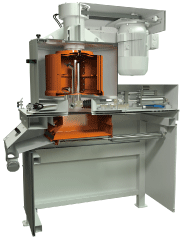The separation of solids from liquids – also the separation of different liquids from each other -- by centrifugal force is a technology that has been around for many decades. For example, because of their numerous economic and environmental advantages, in the field of mass finishing, centrifuges have more or less completely displaced chemical wastewater treatment systems. Centrifuges remove the metal and media fines from the process water so effectively that the cleaned water can be re-used in the mass finishing process. This helps reduce water consumption by up to 90%. An additional benefit is that the centrifugal process does not take out the compounds but leaves them in the cleaned process water, another significant cost-saving. Centrifuges are increasingly used for cleaning and recycling of all kinds of liquids used in industrial manufacturing processes like washing/cleaning, painting, ceramic and glass grinding, stone cutting and wet blasting as well as machining, stamping, wire drawing, quenching, etc.
Water and oil are indispensable tools for industrial manufacturing processes!
The primary liquids used in manufacturing processes are water and oil or a mix of both in the form of emulsions. Water is mainly used for washing/cleaning but also for cooling and dust prevention. For example, metal parts must be washed after machining and stamping, or investment castings must be rinsed off for the removal of ceramic shell residue. For cooling and dust prevention, water and emulsions are used in glass grinding operations such as lens grinding, cutting and grinding of technical ceramics or for stone cutting. But water is also employed for catching the overspray in painting operations using wet paint.
Oil and emulsions (Picture 1) are the primary media for lubrication and dissipation of heat. For example, emulsions are indispensable in machining operations for metal parts, whereas oil is utilized in cutting operations such as stamping, wire drawing and quenching (the rapid cooling of metal components after heat treatment), etc.
The problem of contaminants in the process liquid
The downside of all these washing/cleaning, cooling, dust prevention and lubrication operations is that over time, the process liquids become contaminated with all kinds of unwanted adverse substances. For example, the water from industrial washing operations can be polluted with tramp oil, metal fines and other solids such as dust, ceramic particles, etc. Likewise, machining emulsions pick up tramp oil and small metal particles of debris, whereas the emulsions used for glass and ceramic grinding will get contaminated with glass and ceramic fines.
As these contaminants accumulate in the liquid, its functionality diminishes, and unless it is regularly cleaned, it will become totally useless and can even become a health hazard for the staff dealing with it. At a certain point, the liquid will have to be disposed of, at sometimes extremely high costs.
A quick overview - industrial liquids and their contaminants
The table below shows the most common industrial liquids and the contaminants they pick up:
Cleaning and disposal can be expensive and complicated
Some liquids like the wastewater from washing operations can be cleaned in a company’s central wastewater treatment plant before discharging the cleaned water to drainage. Of course, onetime use of water is expensive and not eco-friendly, while the water treatment itself is tying up personnel and requires costly coagulants and flocculants.
For the removal of paint sludge from the water used in paint booths or collecting tramp oil from wash water and emulsions, skimmers are an option, though not very effective. Many companies are still using cascade settlement tanks to catch the pollutants in their industrial liquids. Apart from the fact that settlement tanks are rather inefficient, they must be cleaned out from time to time, and this is usually a very messy and costly operation.
For certain industrial liquids such as cutting oil, cartridge filters can be used for the final cleaning stage, but this generally requires several pre-cleaning steps, otherwise the cartridges would become clogged very quickly and would have to be exchanged with new ones within very short, totally uneconomical time intervals.
Eventually, the contaminated liquids must be disposed of by professional waste disposal companies. This is not only very expensive but also bad for the environment.
Centrifuges not only clean industrial liquids but also allow their recycling!
An effective and economical way out of this dilemma are centrifuges! By way of an extremely high centrifugal force they remove about 99.9% of the solids from the liquids. But centrifuges can do a lot more: besides taking out solid particles, certain centrifuge types can also separate out tramp oil from wash water and emulsions. After passing through a centrifuge, the liquids are so clean that they can be recycled back into the respective manufacturing process for re-use. This saves not only costs but valuable resources as well; truly a win-win situation!
How do centrifuges work?
The centrifugal principle takes advantage of the fact that the solid contaminants in the wash water, emulsion, etc., are heavier than the liquid itself. Likewise, water and emulsions have a higher density than pure oil.
The high-speed rotation of the centrifuge drum generates a force of over 2,000 G. Compared to this the maximum force in a fighter jet reaches about 10 to 15 G. This high G-force separates the solids from the liquid, and can also separate different liquids such as water and oil.
The function of a centrifuge is shown in picture 2: The polluted liquid (brown color) is pumped into the drum rotating at a speed of 2,800 to 3,200 RPM. The solids – being heavier than the liquid – are deposited on the drum wall in the form of sludge consisting of about 75% of solids and 25% of liquid (Picture 3). The separated, now clean liquid remains on the inside, where it is picked up by a collecting tube (blue color) and recycled back to the manufacturing process for re-use. The accumulated sludge must be periodically removed from the drum.
2-phase and 3-phase centrifuges
For industrial applications, generally 2- and 3-phase centrifuges are utilized. While 2-phase centrifuges separate the solids from the liquid phase as shown in Picture 2, 3-phase centrifuges simultaneously separate the solids and two liquids such as water or emulsions and tramp oil. These centrifuge types are equipped with two collecting tubes – one for water/emulsion and one for the separated oil (Picture 4) Also, 3-phase centrifuges are running at about a 20% higher drum speed.
Semi- and fully automatic centrifuges
Users can choose between semi-automatic and fully automatic centrifuges. In semi-automatic centrifuges, so-called basket centrifuges, the basket insert has to be manually removed from the drum for discharging the accumulated sludge. In fully automatic centrifuges, the sludge is automatically peeled out of the rotating drum with a peeling knife and dumped into a sludge cart placed below the drum (Picture 5). The choice between semi-automatic and fully automatic centrifuges depends on the volume of liquids that must be cleaned and the generated amount of sludge. If the sludge basket in a semi-automatic centrifuge must be emptied frequently; for example, several times per shift, it is advantageous to use a fully automatic centrifugal system.
The economic and environmental benefits of centrifuges
Apart from the fact that they represent a certain capital expenditure of between $ 20,000.00 up to 100,000.00, centrifuges have no downsides but offer numerous advantages:
Centrifuges are very easy to operate and demand very little time by an operator.
Centrifuges require no legal permits from water or other environmental authorities.
Recycling saves valuable resources:
In mass finishing, wet blasting and industrial washing applications, centrifuges help reduce the water consumption by up to 90%.
In machining, glass and ceramic grinding operations, etc., where emulsions are employed, centrifuges can extend the usable life of the emulsions ten-fold before they must be disposed of. The same is true for cutting oil.
By constantly aerating the liquid, centrifuges lower the risk of bacterial infection increasing the usable life of this liquid.
The centrifugal process does not touch any chemical ingredients in the liquid such as surfactants in wash water, compounds in mass finishing process water, biocides, etc. They remain untouched, and can therefore be re-used. This greatly reduces their consumption.
All this results in considerable cost savings!
Above all, centrifuges for cleaning and recycling of industrial liquids can make an invaluable contribution towards environmental sustainability!
Some centrifuge success stories
Centrifuges are suitable for cleaning practically any liquid. Below are a few examples of successful applications:
Glass grinding: Removal of the glass fines from the cooling emulsion.
Painting booth: Removal of the paint sludge from the water that catches the overspray.
Investment casting: Removal of ceramic fines and dirt from the water used for rinsing off ceramic shell residue from the castings and washing (sanitizing) the equipment in the “dip” room.
CNC machining: Removal of metal fines and tramp oil from the cooling and lubricating emulsion.
Good Vibrations
by Eugen Holzknecht
Contributing Editor MFN and
Rösler Oberflächentechnik GmbH
E-mail: holzknecht.usa@gmail.com


































